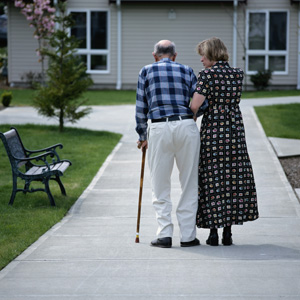
Falls are becoming more routine for the senior population, affecting an average of one out of every three persons older than 65 who lives independently in their own home.
by Marc Katz —
A few years ago there was a commercial whose tagline proclaimed, “Help! I’ve fallen and I can’t get up.” As we age, we are faced with a different series of problems than those we faced in our youth, the most prevalent of which is falling, sometimes fatally.
Falls are becoming more routine for the senior population, affecting an average of one out of every three persons older than 65 who lives independently in their own home. The numbers increase to one out of every two for those older than 75. The statistics become even more staggering, with 70 percent of accidental deaths in people older than 75 resulting from falls.
Our nation is faced with an estimated $129 billion paid out in medical expenses each year because of falls. Yet with this increase in medical costs, we sit idly and watch our parents, grandparents and friends suffer needlessly, with little to no intervention. Are there simple solutions we could be implementing to combat this debilitating and paralyzing threat that plagues our senior population? Or do we simply hope and pray that our loved one will not become another statistic?
The U.S. Congress addressed these very issues by introducing the Elder Fall Prevention Act of 2002 (recently passed as Senate Bill 845), which will allow for public funds to be used for the education of seniors in fall prevention, as well as for the funding of research for services to be extended under Medicare and Medicaid.
Falls may be preventable, but it takes a little work, a little planning and sometimes a little courage. What options do seniors and their families have for addressing this concern? First, they must understand who is at risk for a fall (see sidebar). The risk of a debilitating fall increases as the risk factors in one’s life increase.
There are numerous reasons people fall, many of which are genetically dictated:
- 65 years old or older
- Thin
- Early onset of menopause
- Foot disorders
- Poor oral hygiene (ill-fitting dentures)
- Parkinson’s disease
- Alzheimer’s disease
- Family history of falls
And numerous other factors may predict a senior’s likelihood of falling. If you feel that you or a loved one are at risk, seek help immediately. We recommend starting with your doctor or pharmacist.
Physical or environmental factors that can cause falls
- Four or more medications
- Loose carpeting and/or throw rugs
- Low blood pressure
- Unstable chairs
- Visual deficits
- Poor lighting
- Balance disorders
- Stairs
- Weakness/muscle tightness
- Lack of bathroom safety equipment
- Slowed reflexes
Safety first
Take with you all the medications currently prescribed by all your physicians, as well as any over-the-counter medications you take regularly (in their original bottles). Ask your healthcare professional if any of them can cause drowsiness, dizziness or balance problems when used with any of the other medications you are taking.
Secondly, talk to your doctor if you have experienced hearing, visual or balance changes within the past 12 months. Tell him or her if you have fallen in the past 12 months, as well. Many people have a difficult time discussing these matters with their doctors, but the information is imperative if the problem is to be corrected or avoided in the future.
Ask your physician if there is an appropriate exercise program that incorporates strengthening, balance and endurance that might help you. This may call for a referral to a physical therapist for a number of visits.
Third, we must review the safety of our own homes. Do you have throw rugs that can cause tripping? Are there routine items on the floor or overhead that can cause your center of balance to be shifted, causing a fall? Do you have bathroom safety equipment, such as grab bars, skid strips in the shower or tub, and a shower chair?
Are your hallways and bedroom well lit? Consider placing a night-light in each of these areas to illuminate walking paths.
In most cases, falls can be prevented. Routine home safety checks, exercise and education go a long way. As the American Academy of Orthopedic Surgeons puts it, “She says she wants to keep living in her home. We say it starts by keeping her on her feet.”
There is no need for a senior to live in fear, or to be displaced physically from their life. We just have to help keep them standing.
Marc Katz, of Hearts of Joy Senior Care, Inc., speaks throughout the Valley on numerous topics related to senior care, with a primary focus on fall prevention and home safety. 480-948-4655.
Reprinted from AzNetNews, Volume 26, Number 5, October/November 2007.





September 14, 2012
Alzheimer's and Dementia, Exercise, Parkinson's disease, Seniors